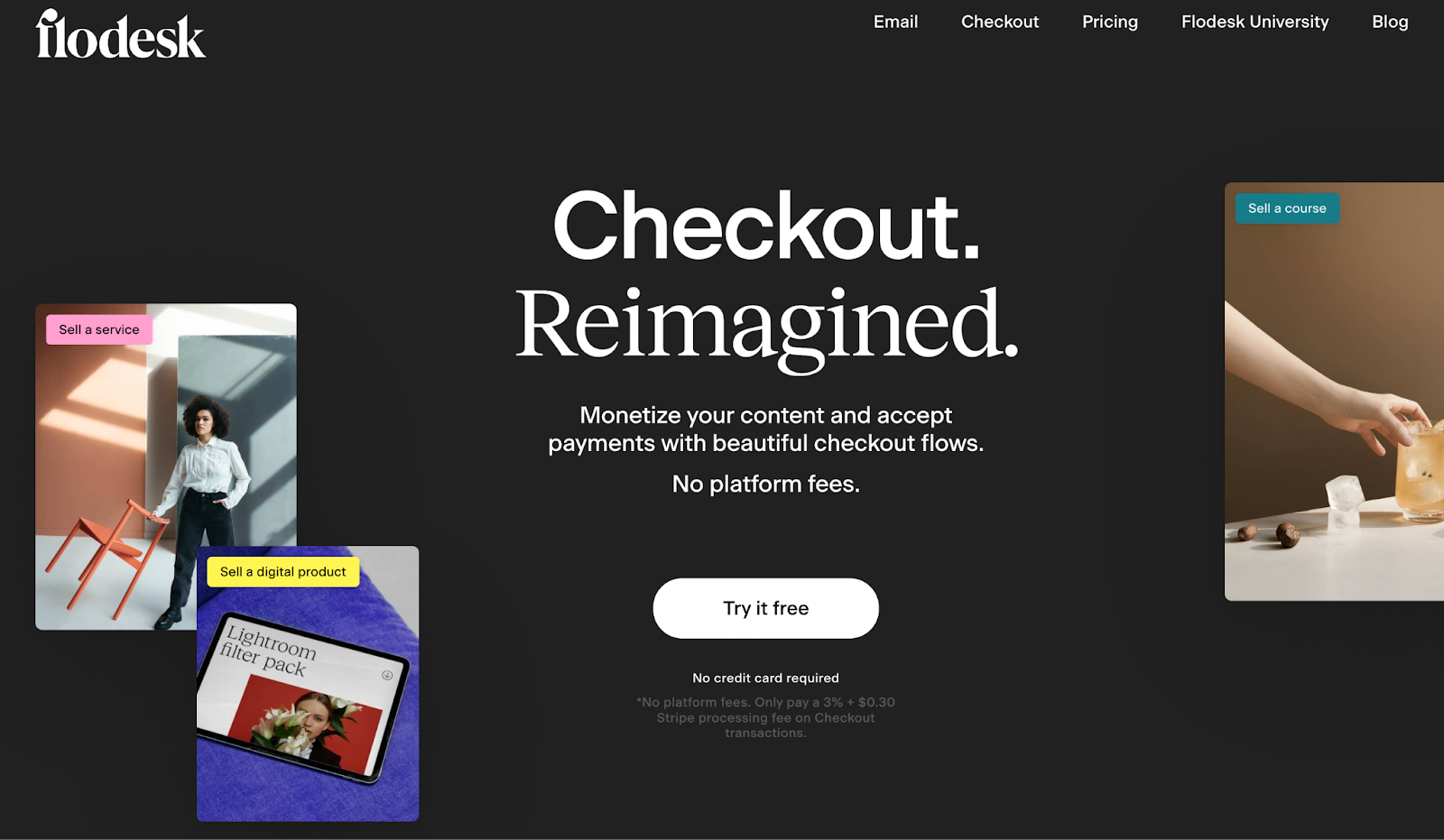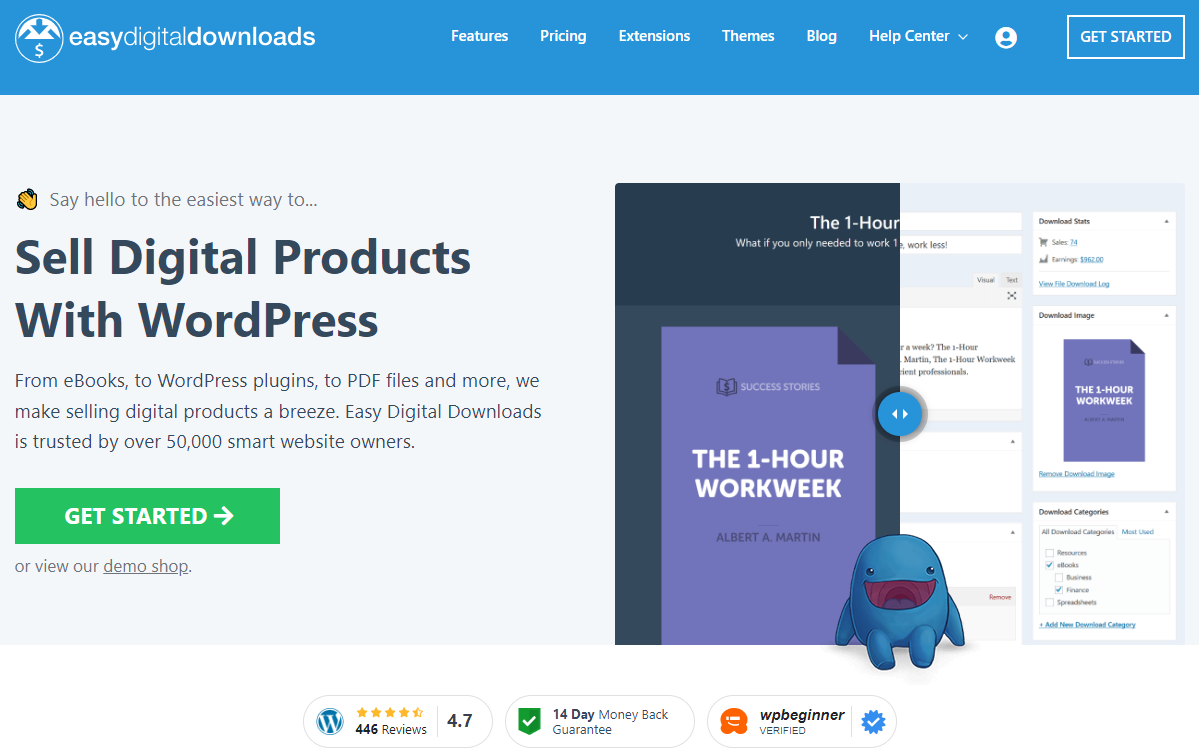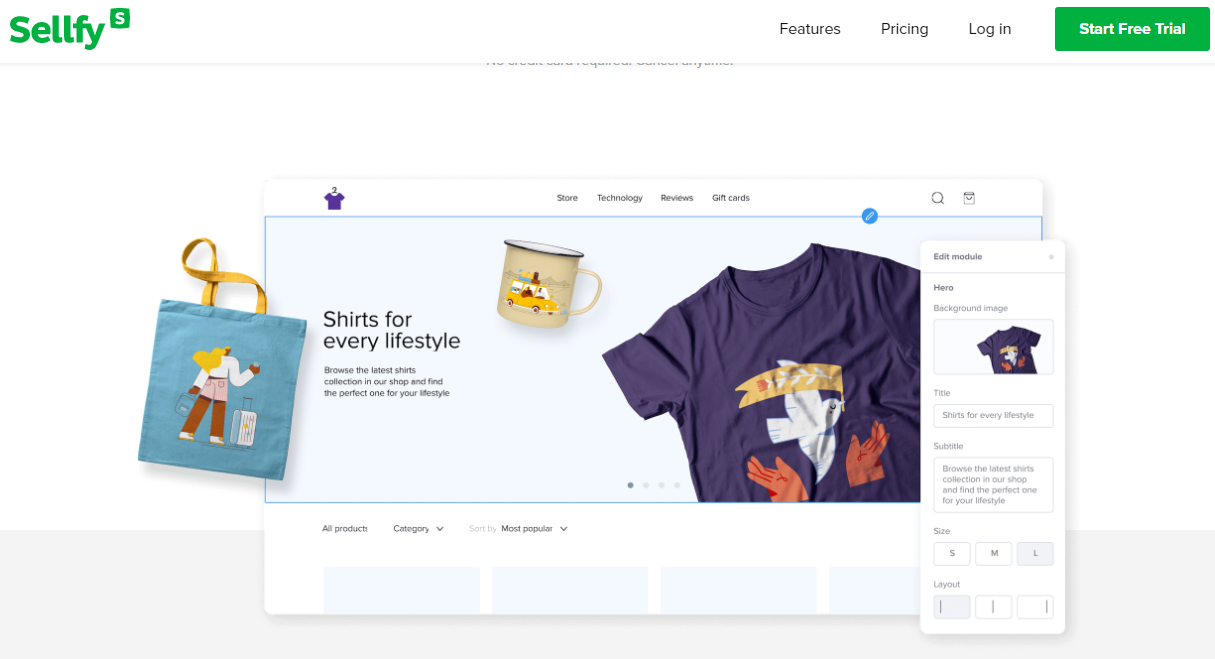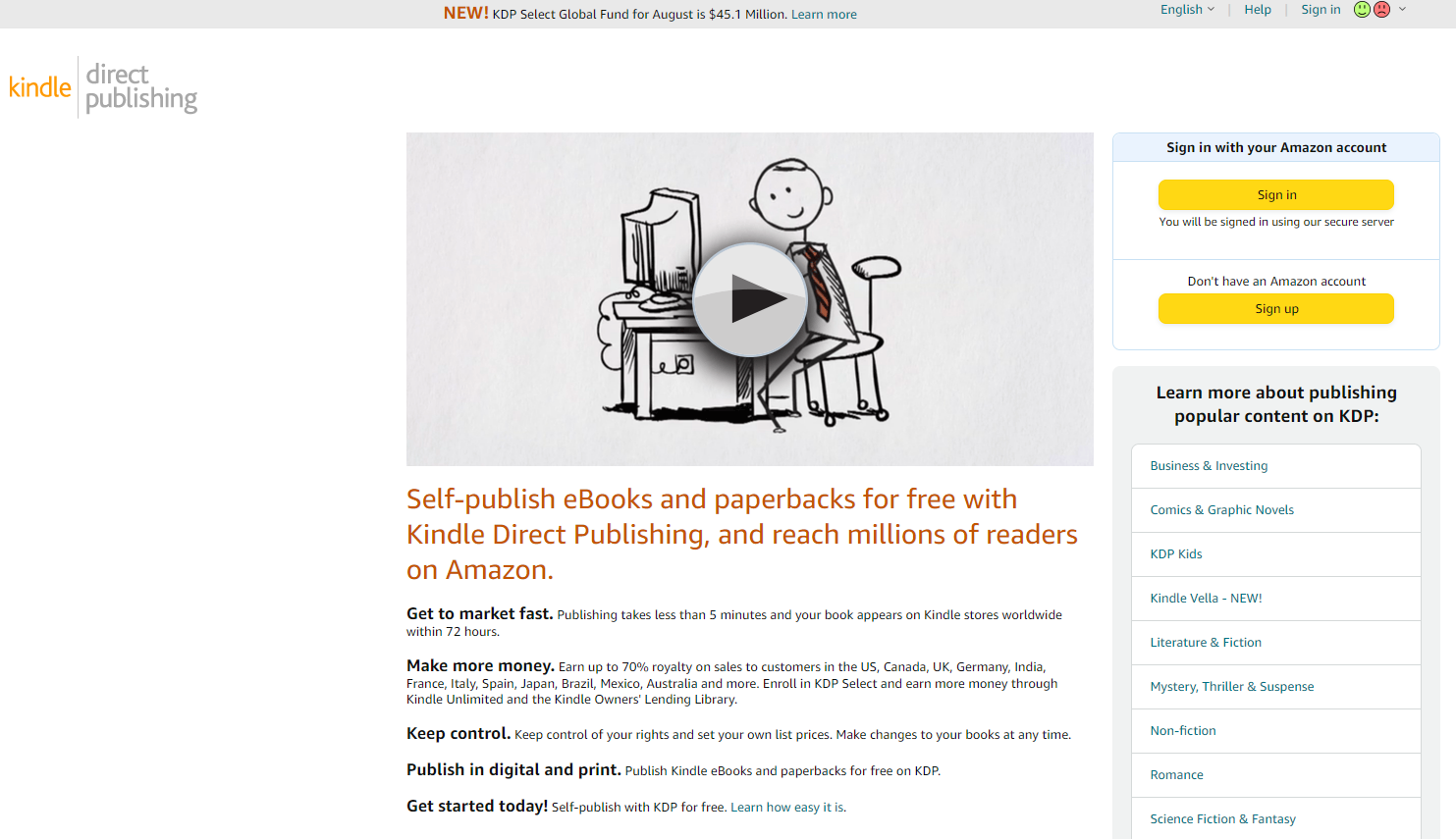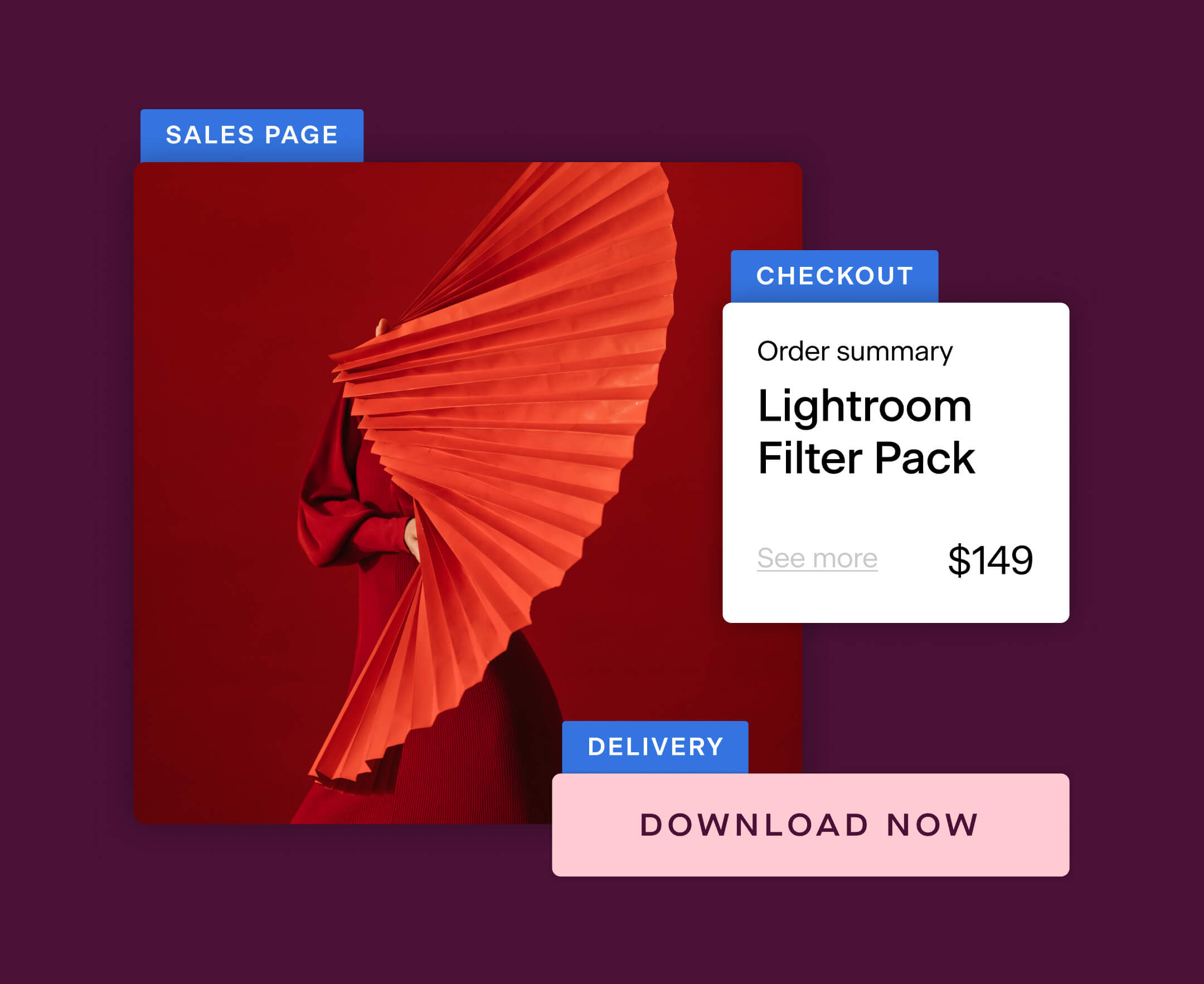How to Sell and Market Digital Products
Table of Contents Jump to:
Jump to:
Table of contents
TL;DR: Selling digital downloads is a great way for entrepreneurs and creatives to earn a passive income. We’re sharing everything you need to know about how to sell digital downloads, with helpful tools, solutions, tips, and tricks to get you started.
A lot goes into selling digital downloads—creating your product is only the beginning of your journey. Your digital downloads won’t sell themselves. You need to find your ideal customers online, then find a way to market and sell it to them.
We’re here to cut through the noise and help point you in the right direction. With this guide, you can transform your downloadable offer into a steady stream of passive income.
Quick look: types of digital downloads to sell
At a high level, here’s a list of the different types of digital downloads you can sell (as a source of inspiration):
- Ebooks: Tap into the growing market of digital readers by selling ebooks in formats like PDF or Kindle that your audience can access on e-readers, tablets, or computers.
- Templates: Save businesses and creatives time and effort by offering pre-designed templates for documents, presentations, or graphics that they can easily customize to meet their needs.
- Graphic design: Monetize your design skills by selling icons, fonts, illustrations, and design assets in formats like PSD, AI, or PNG. Give other creatives and businesses the tools they need to enhance their projects with stunning visuals.
- Music: Offer digital music downloads, including MP3 files, albums, and singles, for personal and commercial use. Empower listeners to build personalized libraries and enjoy instant access to the music you sell.
- Photos and art: Individuals and businesses often require beautiful and unique content for personal or commercial use. Showcase and sell your high-resolution images, digital art, photography, and prints to a global audience.
- Videos: Create and sell video courses, creative short films, and tutorials to entertain or showcase your expertise.
- Printables: Make an income selling printables such as worksheets, planners, calendars, coloring books, and PDF templates. Offer practical and customizable organizational tools for personal, educational, and professional use.
- Courses and tutorials: Share your expertise by creating and selling educational content, online courses, webinars, and instructional videos in digital formats. This is especially easy to do if you already have a ton of great content related to your niche.
- Stock footage: Cater to the content creation industry by selling high-quality video clips, animations, and stock footage. Filmmakers, advertisers, and creatives are always seeking out professional-grade visuals for their projects.
- Challenges: As a coach or expert, monetize your knowledge and teaching prowess by creating and selling challenge programs. For example, a yoga teacher might sell a 30-day yoga challenge. Similarly, a professional coach could develop a week-long program with downloadable resources for a professional development challenge.
- Planners/prepping guides: Tap into the organizational market by selling digital planners and prepping guides. Offer individuals and businesses customizable tools and strategies to help with food planning, sales preparation, and other organizational tools.
This list is just the tip of the iceberg. Check out this guide for more ideas for digital products to sell in every niche and industry.
Get unlimited email sends and subscribers with Flodesk
We’ll never increase pricing because your email list is growing
Top tips to sell your digital downloads
Creating a stellar downloadable digital product is only half the battle—you still have to market it and sell it. Here’s our best advice to get your digital products the attention they deserve.
Tip #1: Know your customers
There’s a common reason why many promising products fail to launch—their creators don’t understand who they’re selling to and what matters most to their target buyers. Don’t make the same mistake: get to know your customers and what makes them tick. It’s why the market research industry is a billion-dollar industry.
One way to gain insights is to find out where your target customers spend their time online. Online spaces like blogs, social media posts, and forums can be helpful sources where you get to know your audience better. Make a point of engaging with people in these digital spaces, or spend time observing their interactions.
As you interact, seek out answers to the questions below, as they relate to your digital download:
- What problems are your ideal customers facing?
- What language do they use?
- What are they afraid of?
- What’s painful about their current situation?
- How can your download improve their life?
- What do they want to achieve?
- How will your download help them achieve that?
- Why are they not satisfied with the existing options?
- What could their life look like with your download in it?
Keep notes on anything you discover. This will help you position your download as something people need, not just something they might want. Jules Acree is an awesome example of how understanding your customers can help you tailor your products and language to appeal specifically to them.
Jules has used her knowledge of her customers to present her Simplify and Thrive Course. The messaging on her page leads with the benefits of creating more time, energy, and space for what matters most in life.
You’ll also notice that Jules has prominently displayed testimonials from customers who personally vouch for the positive experience they’ve had with the course. By tapping into the value people have gotten from the course, Jules demonstrates how she has helped her audience overcome some of their pain points in life.
Tip #2: Choose your marketing channels
There are countless ways to market your digital downloads: email marketing, social media, search engine optimization (SEO), paid ads, influencer marketing, affiliate marketing, selling on Pinterest, and even word of mouth.
In an ideal world, you might promote your products on every available channel. But in the real world, this isn’t always possible—especially if you’re a solopreneur wearing all the business hats. Our best advice is to play to your strengths when marketing.
- Are you a strong writer? Start a blog and tap into organic traffic through SEO
- Are you a social butterfly? Social media allows you to build an online community while generating attention for your digital download
- Do you have design chops and write persuasive copy? Email marketing and paid ads could serve you well, alongside social media
As you consider your options, remember that successful entrepreneurs know when to hire someone to do what they can’t do themselves. If you’re serious about selling digital downloads, invest in your offer by hiring an expert if you need to. This person can help tackle the marketing channels you’re less comfortable with.
And what else do successful entrepreneurs do? They don’t let opportunities go to waste. A social media link in bio—like Flodesk’s Link in bio—is a fantastic way to start monetizing your existing audience for free and with minimal effort.
Your Link in bio sits prominently in your social profiles, directing your followers to a landing page that contains all your essential links to the digital downloads, courses, or products you want to promote. It also captures email addresses right from your social profile, making it easy to grow your list and share promotional emails about your downloadables later.
Turn followers into subscribers with a Flodesk Link in bio
Capture followers’ emails right from your social profiles to grow your list.
Our top tips for marketing your digital downloads across channels
Different marketing channels give you new opportunities to reach your audience. Here are some tips to leverage them just right, and create awareness for your digital downloads.
- Email marketing: Get your message right to your audience’s inbox by building and maintaining an email list of potential customers. Keep them engaged by consistently sending exciting newsletters, complete with product updates and promotions. Maximize your impact by segmenting your email list. Tailor your messages to specific customer interests and preferences, fostering a more personalized connection.
- Social media: Leverage platforms like Facebook, Instagram, Twitter, and LinkedIn to engage with your audience. Share compelling content related to your digital products, add relevant hashtags to improve content discoverability, encourage followers to share user-generated content, and use a Flodesk Link in bio to encourage signups and to direct people to your top links.
- SEO: Boost your visibility online by optimizing your website and product listings for search engines. Do a keyword research exercise and implement on-page SEO best practices to create valuable content that’ll attract audiences.
- Paid ads: Consider running targeted paid advertising campaigns on platforms like Google or Meta. Create specific campaigns to suit goals such as increasing product awareness or driving downloads. Set your budget, define your demographic and their interests, and closely monitor your ad performance, adjusting as needed.
- Influencer marketing: Identify influencers you’d like to work with who can promote your digital products. For the greatest impact, ensure their audience and values align with your target market. Collaborate to create sponsored content that resonates, boosting your downloads’ visibility and credibility.
- Affiliate marketing: Establish an affiliate program and onboard partners to promote your digital products. Incentivize affiliates with a commission for every sale. The best way to do this is to use an affiliate marketing platform like Amazon or AvantLink to manage partnerships and provide sales tracking.
- Evergreen Pinterest pins: Take advantage of evergreen platforms like Pinterest to gain ongoing exposure for your products. Create visually appealing and shareable pins for your digital products on Pinterest, using the platform’s shopping features to sell directly. Additionally, make an effort to engage with the Pinterest community by joining relevant group boards.
- Word of mouth: Nothing beats referrals. Encourage happy customers to refer your digital products to their friends and family. A referral program with incentives can motivate your customers to share their positive experiences. And don’t forget to prioritize exceptional customer service to organically drive positive word-of-mouth marketing.
Tip #3: Be flexible with pricing
It doesn’t always pay to draw a line in the sand and say, “This is my product, this is my price; take it or leave it,” especially when you’re just starting out. Offering a cut-back version of your product for a cheaper rate can serve as an introduction that helps guide potential buyers to becoming paying customers.
Other ways to be as flexible (and appealing) as possible include offering a freebie of sorts, if it makes sense for what you’re selling.
Sell ebooks? A free chapter can be just the bait someone needs to hit checkout on the full product. Sell design templates? Provide free access to a limited library of templates or an enticing freebie like an icon pack. These tactics allow people to get a taste of how great your products are before committing to a purchase.
See how Birdesign makes this strategy work. By joining their newsletter, their audience can access over 135 free design resources and a monthly freebie. With that many great resources on offer, it’s just a matter of time before an active member levels up to make a purchase.
Another tactic is to offer guarantees for your downloads. Think about how often you were on the fence about buying something, but then a 14-day money-back guarantee sealed the deal.
This model won’t apply to every business, but if there’s any way you can include a money-back guarantee, it’s a powerful persuasion strategy that goes a long way in convincing people to try your product or service.
Recommended reading: How to price digital downloads
Tip #4: Form partnerships
“It’s not what you know, it’s who you know.”
Truer words were never spoken. Whether you partner directly with a well-known brand or influencer or host your download on an online marketplace like Amazon, partnerships expose you to a world of new buyers you wouldn’t otherwise have access to.
Even working with friends and family can be a form of partnership. Many professionals offer affiliate rewards to incentivize people—like their friends, colleagues, or customers—to make sales on their behalf. This is the ultimate partnership, where you create an army of sales reps who only receive compensation for what they sell. It’s no surprise the affiliate marketing industry is set to reach $15.7 billion by 2024.
Tip #5: Niche down to grow exponentially
It’s a widely accepted truth that your ideal customer cannot be “everyone.” Get specific and appeal to your niche. Speak to that one person and make your offering so compelling that they have to buy. In other words, cater to a highly specific need rather than a general one and you’ll boost your sales.
It’s natural for people to gravitate toward products that are specifically designed for them. For example, an artist looking to get into drawing graphic novels is going to be more receptive to accessing free digital drawing tools than a download aimed at watercolor painters.
Read next: How to sell Canva templates
6 solutions to sell digital downloads
Now that you’re ready to sell, the next question becomes, “How and where to sell digital downloads?” The online landscape is stacked with e-commerce solutions fit for the task, and you’ll have to find what works best for you.
The list below aims to cover every angle, from complete online stores to “buy now” buttons, and solutions designed for specific types of digital content.
1. Flodesk
Sales and checkout platform with integrated email marketing.
Who it works for
Flodesk Checkout is perfect for anyone who wants to sell digital products or services through a fully branded online store. Use it to build a gorgeous sales page to display your digital download, provide a seamless payment gateway for customers to purchase your offer, and design a delivery page where they can instantly access their purchases.
Case in point: check out the amazing store that Flodesk member Katie Moore put together to sell her new cookbook.
That’s not all. With Flodesk Checkout, you also have access to Flodesk Email—a powerful email marketing platform that makes it easy to design emails people love to get. Get the tools you need to build, engage, and monetize a list of loyal fans ready to buy your downloads.
At a minimum, you can use a Flodesk Link in bio (completely free) to drive your social media followers directly to your sales page, your newsletter signup, and any other page or platform you want to get eyes on.
Features
- Gorgeous customizable templates you can tailor to sell digital downloads, educational content, and online services
- Easy to use drag-and-drop builder to design forms, sales and landing pages, emails, and much more
- Sales pages that look great on mobile and all devices, no website needed
- Direct integration with Stripe for swift payments with low fees
- Access to Flodesk’s powerful email marketing features
- A free, beautifully branded Link in bio for social media
Flodesk |
PROS |
|
CONS |
|
Pricing
You can start free with Flodesk for 30 days, no credit card required. This will give you unlimited access to all of the e-commerce functionality.
When you’re ready to sign up, we offer unlimited everything with straightforward pricing.
- Link in Bio: Completely free
- Add email marketing: $35/month (email marketing without e-commerce)
- Add e-commerce: $24/month
Get a sales and checkout page to sell your products with ease
Monetize your content and accept payments with beautiful checkout flows. No platform fees.
Read next: The ultimate guide to Flodesk Checkout
2. Easy Digital Downloads
Easy plugin for WordPress websites.
Who it works for
If you already have a WordPress website and don’t want the hassle of starting your store from scratch, Easy Digital Downloads could be just the plugin for you.
This plugin is designed to work alongside any WordPress theme, giving you the necessary features of an online store for your existing website.
Features
- Flexible payment options
- Unlimited file downloads
- Fully functional e-commerce experience, including discount codes
- Activity tracking
- Integration with leading apps like AWeber, Mailchimp, Dropbox, and Stripe
- Wishlists, product comparisons, fraud monitoring, and other advanced features available through their top-tier plans
Easy Digital Downloads |
PROS |
|
CONS |
|
Pricing
Easy Digital Downloads has four pricing tiers: Personal, Extended, Professional, and All Access Pass. Each tier unlocks additional features, and to create a fully-featured digital store, you’ll likely need one of their higher tiers.
Here’s how the prices pan out:
- Personal: $199/year
- Extended: $399/year
- Professional: $599/year
- All Access: $999/year
3. Sellfy
A low-cost way to create an all-in-one online store.
Who it works for
Sellfy gives you a quick and simple way to set up and launch your online store. They claim it’ll take less than five minutes to have your e-commerce store up and running.
Not only is Sellfy famously simple to use, but it also allows you to expand comfortably into the world of print-on-demand—which is handy if you have your eye on selling physical products one day.
Features
- Accept payments via PayPal or card (powered by Stripe)
- Print-on-demand features available
- Marketing tools, including basic email marketing, cart abandonment email automation, discount codes, upsells, and pixel tracking
- Mobile-optimized e-commerce experiences
- Comprehensive analytics
Sellfy |
PROS |
|
CONS |
|
Pricing
Sellfy has a generous free plan that will cover you for up to 10 physical products (including print-on-demand). But to sell digital downloads, you’ll need their Starter plan (at a minimum).
Each paid plan gives you unlimited products while unlocking additional features. For e-commerce essentials like removing the Sellfy branding, product upsells, and cart abandonment, your eye should be on their Business or Premium plans.
Here’s a quick overview of each plan’s pricing and limits:
- Starter: $29/month for up to $10,000 in yearly sales
- Business: $59/month for up to $50,000 in yearly sales
- Premium: $119/month for up to $200,000 in yearly sales
If you make more than $200,000 in annual sales, you’ll need to contact Sellfy for a bespoke quote.
4. Amazon KDP
One of the easiest ways to sell downloadable ebooks globally.
Who it works for
If you’re creating ebooks as your digital download of choice, Amazon KDP is as easy as it gets.
You sell directly through the Amazon marketplace, meaning you can tap into Amazon’s billions of global customers. The downside is that this won’t set you up with the infrastructure to sell your download via your website—you’ll have to link to the Amazon page instead.
Features
- Easy-to-navigate platform
- Publishing can take less than five minutes
- Generate product sales through free downloads or timed promotional discounts
- Enroll your ebook download in Kindle Unlimited and claim your share of a $45+ million monthly global fund
- Grab a free ISBN for your ebook
Amazon KDP |
PROS |
|
CONS |
|
Pricing
It costs nothing to list your ebook download through Amazon KDP. Their only fee is a 30% take from each digital download.
5. Etsy
A creative marketplace with secure payment processing and an established customer base.
Who it works for
Etsy, originally renowned for selling handmade and vintage goods, is now a popular space for selling digital downloads. Creative entrepreneurs list and sell everything from digital art prints to printable planners and music downloads to a global audience seeking unique creations.
With its user-friendly interface, established customer base, and secure payment processing, Etsy is an attractive platform for individuals looking to transform their creative digital assets into a thriving online business.
Features
- App to manage orders, respond to customers, and edit your listings
- Built-in payment processing
- Advertising tools, including Etsy Ads and Offsite Ads
- Access to analytics for your store
- Customer support from Etsy via email or phone
Etsy |
PROS |
|
CONS |
|
Pricing
Etsy charges to list your downloads. After that, you’ll pay several fees as and when you make a sale. Here’s what to expect:
- Listing fee: $0.20/product
- Transaction fee: 6.5% of displayed product price
- Payment processing fee: 3% plus $0.25 per transaction
Any charges for advertising on Etsy are over and above that. Check out Etsy’s pricing page to get more information.
6. Digital Product Delivery (DPD)
The cheapest option for selling digital downloads.
Who it works for
Digital Product Delivery (DPD) is ideal for creators looking for a cost-effective way to sell digital downloads via a “Buy now” button.
It’s one of the easiest ways to start selling your download. Just upload your product files, copy and paste DPD’s cart button, and you’re done. The only catch is you need somewhere to plant that button—a blog, your website, or even Facebook will do.
Features
- Zero-coding simple HTML buttons and link text options to sell your digital downloads
- Accept payments via PayPal, Stripe, Authorize.net, and more
- Over 500 integrations available, including ConvertKit, Google Analytics, and Zapier
- Easily sell downloadable products or subscription memberships
- Mobile-responsive checkout experience
- PDF stamping and encryption to uphold your copyright
- Coupons and discount codes
DPD |
PROS |
|
CONS |
|
Pricing
DPD offers a 30-day free trial to get you started. After that, they base prices on how many products you’re selling and how much space they take up.
Here’s a quick look at how pricing starts:
- $10/month for up to 20 products with 1GB of total product space
- $16/month for up to 35 products with 2GB of total product space
- $30/month for up to 120 products with 6GB of total product space
- $45/month for up to 250 products with 12.5GB of total product space
Get a sales and checkout page to sell your products with ease
Monetize your content and accept payments with beautiful checkout flows. No platform fees.
Ready to sell?
Selling digital downloads can be lucrative, but you need an action plan to make a successful venture of it. Having an idea is only step one.
To succeed, you need to commit considerable effort to understand your target customer and create a solid marketing strategy. From there, choose the best way to sell digital downloads based on your business model and goals.
With Flodesk, you can set up a stunning online store in a matter of minutes, turn social followers into subscribers, and nurture relationships through gorgeous email marketing. It’s as easy as it gets. Start your free trial.
FAQs
How do I start selling digital content?
- Decide what type of digital product you want to create.
- Do deep research on your target customer until you understand who they are, what they want, what they struggle with, and how your product fits into that story.
- Identify a niche for your digital content, and use that to position your product for a specific audience.
- Document the process of creating the product to help you begin marketing immediately.
- Choose how you’ll sell your product. Options include your ecommerce store, a “Buy now” button for your website or blog, or an online marketplace.
- Build hype for the day you release your download. Check out our list of product launch email templates or our “How to write a product launch email” blog for some inspiration.
How can I sell digital downloads without a website?
Look to online platforms like Flodesk Checkout, Amazon, or Etsy—each of these allows you to sell digital downloads without a website.
What digital downloads sell well?
The possibilities are endless when it comes to profitable digital downloads. Still, there are some standout examples with higher success potential. You can’t go wrong selling digital downloads in these markets:
- Educational courses
- Ebooks
- Licenses for digital files
- Digital art
- Software downloads
- Templates, plugins, and tools
- Music albums and singles
Are digital downloads profitable?
Yes, digital downloads can be incredibly profitable if done right. A tremendous example is Justin Welsh, an online entrepreneur and angel investor, who made $1.3 million in 27 months from selling online courses as a one-man business.
How do I start a digital download business?
Start your digital download business by following the steps we’ve outlined in this blog. Create your first product and gain experience marketing it. Then keep learning, creating new versions and products, and expanding as you do. Make this your priority, and it can swiftly become a full-time business.



